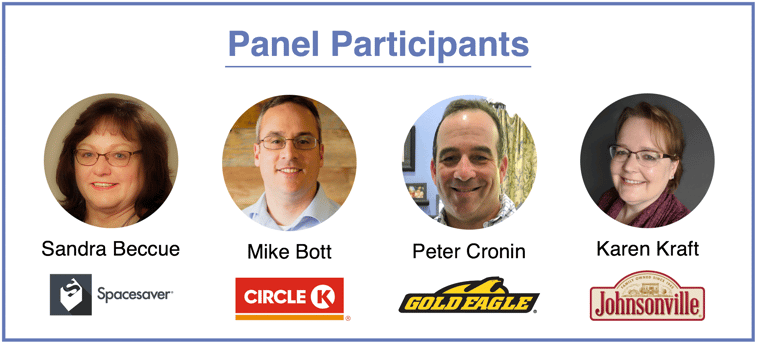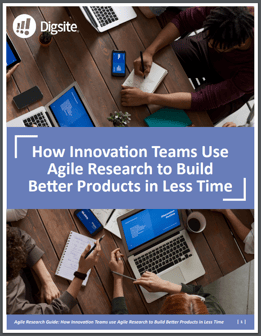When consumer insights leaders come together to talk shop, it’s a good day. I recently moderated a panel of four insights pros who discussed how they deliver innovation at their companies.

Panel Participants:
- Mike Bott, Consultant, Circle K
- Sandra Beccue, Sr. Market Research Specialist, Spacesaver
- Peter Cronin, Director of Consumer Insights, Gold Eagle
- Karen Kraft, Sr. Consumer Insights Manager, Johnsonville
Each of these panelists has experience applying agile principles such as empowering small teams, breaking complex problems into sprints, using rapid prototyping and testing to build solutions, incorporating tight consumer-driven feedback loops along the way, and integrating learning as they build solutions. We dug deeper into how they were applying these principles. Here are some of the top takeaways from our discussion.
Q: How has innovation at your organization changed?
Mike: When I started with Circle K, we were doing 6-8 week engagements for $300k, and now we can do things very inexpensively and come out with better results. The way we think has been completely flipped on its head: how we think about budget, how many bets we can make at a time, how we engage different people from the organization. It has allowed us to move a lot faster and to iterate, taking dozens of small bets instead of just one or two big bets. We now know that speed is something that can go alongside innovation.
Karen: Insights at Johnsonville used to be aligned to the business units. As we were trying to align insights closer to innovation, we really had to look at how the consumer thinks. The consumer doesn’t think about what kind of fully cooked sausage they want; they think, “What do I want for dinner? What do I want for breakfast?” We realigned insights with consumer occasions, and that’s also how our innovation team is aligned. That was a big change and a little uncomfortable at first, but it has really worked and everyone has seen the benefit.
Q: How have you changed your skills or how you work to improve your success in your organization?
Karen: Having the basic skills to do market research is a good foundation, but I rely more every day on my consultative skills, strategic thinking, and being able to create a good story. I joke with my team that you need to write a report like a children’s book. And the higher up the food chain, the simpler the story needs to be.
Peter: What’s enabling us to make some big contributions is being superior communicators. We have to explain a lot of technical things in nontechnical terms. We also rely on creative problem-solving and creative thinking – we live in both a right and left brain world, and you can’t live on just one side to be effective, especially when talking to your board of directors and the C-suite. We also bring an entrepreneurial mindset, which means risk tolerance and the willingness to smartly take a big bet. Not recklessly, but smartly, but it still takes courage. And, finally, we’re flat. Everyone rolls up their sleeves and can do every part of the research process. We are all in the same boat rowing together.
Mike: It’s a bit like building a team of generalists – not specialists – because they have multiple capabilities. People with startup experience are great fits because they’ve had to teach themselves three of four different functional capabilities. It’s about identifying people who are curious and willing to get out of their comfort zone every day and able to bridge into other parts of the organization.
Q: How does agile, as a project management technique, work for innovation?
Peter: We don't necessarily need a fully baked concept to be able to start. We can begin by looking at a piece of an idea or a piece of a business and validate it and learn as we go.
Sandra: You start with the initial question and break it down into small chunks. Each step informs the next step.
Mike: We have taken the research we did through Digsite, and use that as our North star: here’s the problem we’re trying to solve. Then we can deconstruct the different angles. We take a holistic approach to determine the cheapest, fastest way we can get to the next step. At the end of the day, agile is about the team that can move quickly.
Q: What advice do you have for people who want to improve on innovation in their organization?
Mike: It’s never going to go as fast as you want it to go, but if you make it go faster than it was before, you’re winning. Remember that you’re moving a battleship most of the time.
Sandra: It is really important to get not only your core team but the other folks in the organization involved. The core team is focused on the research questions, but we’re bringing in players from other parts of the company, creating an innovation system and more of an engaged group.
Peter: The biggest success is showing the organization what’s possible. Innovation by definition is a discipline that’s fraught with failure. Don’t be afraid of it. Fail fast and early. If it takes you too long to fail, you’ll get too far down the road and then you’re stuck. We can agonize over what price to test this concept at, or we can pick one and see how people react to it and get feedback. Allow for ideas to come from anywhere. Some of our most successful ideas were left-field ideas. If you have an engine that allows you to get feedback quickly, there’s no risk in doing that – and the payoff can be huge.
To learn more about how some of today’s leading organizations are using agile research to delight their customers and drive competitive advantage, check out our eBook: How Innovation Teams use Agile Research to Build Better Products in Less Time.






